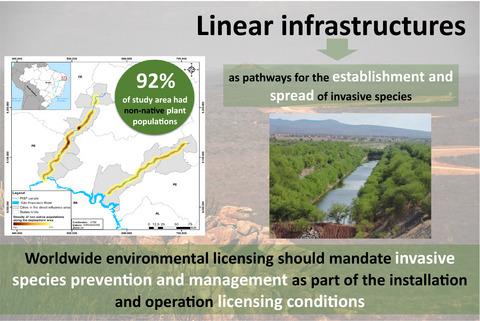当前位置:
X-MOL 学术
›
J. Appl. Ecol.
›
论文详情
Our official English website, www.x-mol.net, welcomes your
feedback! (Note: you will need to create a separate account there.)
Canals as invasion pathways in tropical dry forest and the need for monitoring and management
Journal of Applied Ecology ( IF 5.0 ) Pub Date : 2021-06-16 , DOI: 10.1111/1365-2664.13950 Matheus da Silva Asth 1, 2 , Renato Garcia Rodrigues 2 , Rafael Dudeque Zenni 1
中文翻译:

作为热带干旱森林入侵途径的运河以及监测和管理的必要性
更新日期:2021-06-16
Journal of Applied Ecology ( IF 5.0 ) Pub Date : 2021-06-16 , DOI: 10.1111/1365-2664.13950 Matheus da Silva Asth 1, 2 , Renato Garcia Rodrigues 2 , Rafael Dudeque Zenni 1
Affiliation

|
- Linear infrastructure intrusions are common around the world to meet the needs of a growing and interconnected human population. The implementation of linear infrastructures involves numerous forms and mechanisms of land-use transformation that can facilitate and serve as pathways to the spread of invasive non-native species. However, the type and intensity of land transformations change over time and this can affect the frequency and intensity in which linear infrastructures route the spread of invasive species.
- Here, we present results collected over 5 years of monitoring surveys (2015–2019) to assess the relationship between the construction of one of the largest canals to date in Brazil and the spread of non-native species. We studied the Integration Project of the São Francisco River (PISF), a canal fully inserted in the Caatinga biome, a tropical dry forest ecosystem for which information on invasion dynamics are little known.
- Our results confirmed PISF canals served as habitat and dispersal corridors for non-native plant species. Monitoring surveys recorded 26 non-native species established along the 83.2 km2 PISF deployment area. Eleven years after the canal deployment area was completely cleared of vegetation, 92.3% of its extension had non-native plant populations. Of the 10 species assessed for their population status, 8 had invasive populations.
- The time immediately after construction work finished was the critical stage for the spread of non-native woody plants, which increased their distributions with reduced levels of construction intervention, whereas most of the herbaceous species reduced their distributions. When human intervention was drastically reduced, many populations of non-native plants rapidly formed at the deployment area.
- Policy implications. Man-made linear infrastructures can remove biogeographical barriers and serve as pathways for the spread of invasive species over long distances and across ecosystems. Thus, the planning, construction and management of such infrastructures should include measures and funding for risk assessment, prevention, monitoring and control of biological invasions. Agencies responsible for environmental licensing should mandate invasive species management as part of the installation and operation licensing conditions.
中文翻译:

作为热带干旱森林入侵途径的运河以及监测和管理的必要性
- 线性基础设施入侵在世界各地都很常见,以满足不断增长和相互关联的人口的需求。线性基础设施的实施涉及土地利用转变的多种形式和机制,这些形式和机制可以促进并作为传播外来入侵物种的途径。然而,土地改造的类型和强度会随着时间的推移而变化,这会影响线性基础设施传播入侵物种的频率和强度。
- 在这里,我们展示了 5 年监测调查(2015-2019 年)收集的结果,以评估巴西迄今为止最大的运河之一的建设与非本地物种传播之间的关系。我们研究了圣弗朗西斯科河 (PISF) 的整合项目,这是一条完全插入卡廷加生物群落的运河,卡廷加生物群落是一个热带干旱森林生态系统,其入侵动态信息鲜为人知。
- 我们的结果证实了 PISF 运河是非本地植物物种的栖息地和传播走廊。监测调查记录了沿 83.2 公里2 PISF 部署区域建立的 26 个非本地物种。在运河部署区完全清除植被 11 年后,其延伸部分的 92.3% 有非本地植物种群。在对其种群状况进行评估的 10 个物种中,8 个具有入侵种群。
- 建筑工程完成后的时间是非本地木本植物传播的关键阶段,随着建筑干预水平的降低,它们的分布增加,而大多数草本植物的分布减少。当人为干预大幅减少时,部署区域迅速形成了许多非本地植物种群。
- 政策影响。人造线性基础设施可以消除生物地理障碍,并作为入侵物种长距离和跨生态系统传播的途径。因此,此类基础设施的规划、建设和管理应包括风险评估、预防、监测和控制生物入侵的措施和资金。负责环境许可的机构应将入侵物种管理作为安装和运营许可条件的一部分。











































 京公网安备 11010802027423号
京公网安备 11010802027423号